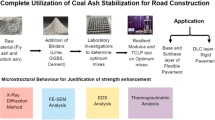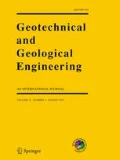Abstract
Increase in production capacity of opencast coal mines is realised through deployment of increasingly larger capacity haul trucks, which require appropriately designed and well maintained haul roads. Use of fly ash-overburden mix can enhance mechanical property of sub-base and at the same time enhance waste utilisation. This paper reports the detailed laboratory investigations carried out on development of fly ash composite materials with mine overburden, clinker and evaluation of their suitability for haul road. Proctor compaction tests, unconfined compressive strength (UCS) tests, california bearing ratio (CBR) tests were carried out at different curing periods. The composite with 62% fly ash, 30% overburden and 8% clinker exhibited adequate strength value for the haul road application.










Similar content being viewed by others

References
ASTM C 618-08a (2008) Standard specification for coal fly ash and raw or calcined natural pozzolan for use in concrete. American Society for Testing and Materials, West Conshohocken, pp 1–3
Bowles JE (1992) Engineering properties of soils and their measurements, 4th edn. McGraw-Hill, Boston, pp 1–480
BS: 1377 Part 2 (1990) Methods of test for soils for civil engineering purposes. British Standard Institution, London, pp 8–200
Butalia ST (2007) Rehabilitating asphalt highways: coal fly ash used on Ohio full depth reclamation projects. Case Study-18, Coal Combustion Product Partnership, Environmental Protection Agency, USA, pp 1–4
Cetin B, Aydilek AH, Guney Y (2010) Stabilization of recycled base materials with high carbon fly ash. J Resour Conserv Recycl 54:878–892
Chu TY, Davidson DT, Goecker WL, Moh ZC (1955) Soil stabilization with lime-fly ash mixtures: preliminary studies with silty and clayey soils. Highw Res Board Bull 108:102–112
Cockrell CF, Leonard JW (1970) Characterization and utilization studies of limestone modified fly ash, vol 60. Coal Research Bureau, Morgantown
Collins JL, Fytas K, Singhal R (1986) Design, construction and maintenance of surface mine haul roads. In: Proceedings of the symposium on geotechnical stability in surface mines, Calgary, pp 39–49
Das BM (1994) Principles of Geotechnical Engineering, 3rd edn. PWS-Kent Publishing Company, Boston, pp 1–672
DiGioia M, Nuzzo WL (1972) Fly ash as structural fill. J Power Div 98(1):77–92
Edil T, Sandstrom L, Berthouex P (1992) Interaction of inorganic leachate with compacted pozzolanic fly ash. J Geotech Eng 118(9):1410–1430
Ghosh A, Dey U (2009) Bearing ratio of reinforced fly ash overlying soft soil and deformation modulus of fly ash. J Geotext Geomembr 27:313–320
Ghosh A, Subbarao C (2006) Tensile strength bearing ratio and slake durability of class F fly ash stabilized with lime and gypsum. Mater Civ Eng 18:18–27
Gopalan MK, Haque MN (1986) Strength development of clinically cured plain and fly ash concretes. In Proceedings of Aus. Road Research Board, 13(5):27–33
IS: 1760 Part 1 (1991) Determination of loss on ignition. Indian standard for chemical analysis of limestone, dolomite and allied materials. Bureau of Indian Standards, New Delhi, p 1
IS: 2720 Part 3 (1980) Determination of specific gravity. Indian standard methods of test for soils. Bureau of Indian Standards, New Delhi, pp 1–8
IS: 2720 Part 4 (1985) Determination of grain size. Indian Standard methods of test for soils. Bureau of Indian Standards, New Delhi, pp 1–38
IS: 2720 Part 5 (1985) Determination of liquid and plastic limit. Indian standard methods of test for soils. Bureau of Indian Standards, New Delhi, pp 1–16
IS: 2720 Part 6 (1972) Determination of shrinkage factors. Indian standard methods of test for soils. Bureau of Indian Standards, New Delhi, pp 1–11
IS: 2720 Part 8 (1983) Laboratory determination of water content—dry density relation using heavy compaction. Indian standard methods of test for soils. Bureau of Indian Standards, New Delhi, pp 1–9
IS: 2720 Part 10 (1991) Determination of unconfined compressive strength. Indian standard methods of test for soils. Bureau of Indian Standards, New Delhi, pp 1–4
IS: 2720 Part 16 (1987) Laboratory determination of CBR. Indian Standard methods of test for soils. Bureau of Indian Standards, New Delhi, pp 1–15
IS: 2720 Part 26 (1987) Determination of pH value. Indian standard methods of test for soils. Bureau of Indian Standards, New Delhi, pp 1–9
IS: 2720 Part 40 (1977) Determination of free swell index of soils. Indian standard methods of test for soils. Bureau of Indian Standards, New Delhi, pp 1–5
Ismaiel HAH (2006) Treatment and improvement of the geotechnical properties of different soft fine grained soils using chemical stabilization. Ph.D thesis, Martin Luther University Halle, Wittenberg, pp 1–120
Jones CW (1958) Stabilization of expansive clay with hydrated lime and Portland cement. Highw Res Board Bull 193:40–47
Kumar V (2005) Fly ash—an opportunity for India. In: Proceedings of fly ash India conference. DST, New Delhi
Mackos R, Butalia T, Wolfe W, Walker HW (2009) Use of lime-activated class F fly ash in the full depth reclamation of asphalt pavements: environmental aspects. In: Proceedings of World of Coal Ash Conference’ 09. Lexington, p 121
Meyers JF, Pichumani R and Kapples BS (1976) Fly ash as a construction material for Highways. Report No. FHWA-FP-76-16, US Department of Transportation, Washington DC
Mishra SR, Kumar S, Park A, Rho J, Losby J, Hoffmeister BK (2003) Ultrasonic characterization of the curing process of PCC fly ash. J Mater Charact 50:317–323
Pandian NS (2004) Fly ash characterization with reference to geotechnical applications. J Indian Inst Sci 84:189–216
Pandian NS, Rajasekhar C, Sridharan A (1995) Fly ash-lime systems for the retention of lead ions. In: Proceedings of Indian Geotechnical conference, Bangalore, pp 219–222
Prabakar J, Dendorkar N, Morchhale RK (2004) Influence of fly ash on strength behaviour of typical soils. Constr Build Mater 18:263–267
Ramasamy G, Kaushik NP (2001) Estimation of settlement of footings on compacted fly ash fills. In: Proceedings of international conference on civil engineering, Bangalore, pp 926–934
Raymond S (1961) Pulverized fuel ash as embankment material. In: Proceedings of the institution of civil engineers 19(4):515–536
Sahu BK (2005) Use of fly ash for stabilizing sub-standard road construction materials in Botswana. In: Proceedings of fly ash India conference, Fly ash utilization programme, TIFAC, DST, New Delhi, pp VIII 10.1–10.9
Sear LKA (2001) Properties and use of coal fly ash. Thomas Telford, London, pp 1–200
Shastry MVBR, Kumar SG (1989) Strength characteristics of lime stabilized clay–sand mixes. Indian Geotechn J 19(1):87–103
Singh RN, Ghosh AK (2006) Engineered rock structure in mining and civil construction. CRC Press, Taylor and Francis Group, London, pp 1–514
Sivapullaiah PV, Prasanth JP, Sridharan A (1995) Optimization of lime content for fly ash. J Test Eval 23(3):222–227
Sridharan A, Prakash K (2007) Physical properties. Geotechnical engineering characterization of coal ashes, Chap 3, 1st edn. CBS Publishers and Distributors, New Delhi, pp 26–53
Tannant DD, Kumar V (2000) Properties of fly ash stabilized haul road construction materials. Int J Surf Min Reclam Environ 14(2):121–135
Tannant DD, Regensburg B (2001) Guidelines for mine haul road design. School of Mining and Petroleum Engineering, Dept. of Civil and Environmental Engineering, University of Alberta, Canada, pp 28–42
Thompson RJ, Visser AT (2003) Mine haul road maintenance management systems. J South Afr Inst Min Metall, pp 303–312
Ulusay R, Arlkan F, Yoleri MF, Caglan D (1995) Engineering geological characterization of coal mine waste material and an evaluation in the context of back-analysis of spoil pile instabilities in a strip mine, SW Turkey. J Eng Geol 40:77–101
Xu A, Sarkar S (1994) Micro structural developments in high-volume fly ash cement system. J Mater Civ Eng 6(1):117–136
Acknowledgements
The authors acknowledge the financial assistance provided by the Council of scientific and Industrial Research (CSIR)-New Delhi under EMR-II Scheme Vide letter No. 22/0474/09/EMR-II dated 12-02-2009.
Author information
Authors and Affiliations
Corresponding author
Rights and permissions
About this article
Cite this article
Mallick, S.R., Mishra, M.K. Evaluation of Clinker Stabilized Fly Ash-Mine Overburden Mix as Sub-base Construction Material for Mine Haul Roads. Geotech Geol Eng 35, 1629–1644 (2017). https://doi.org/10.1007/s10706-017-0198-8
Received:
Accepted:
Published:
Issue Date:
DOI: https://doi.org/10.1007/s10706-017-0198-8



